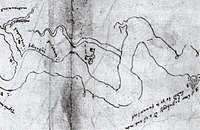Draft:Pedro de Zúñiga y de la Cueva
 | Review waiting, please be patient.
This may take 3 months or more, since drafts are reviewed in no specific order. There are 2,975 pending submissions waiting for review.
Where to get help
How to improve a draft
You can also browse Wikipedia:Featured articles and Wikipedia:Good articles to find examples of Wikipedia's best writing on topics similar to your proposed article. Improving your odds of a speedy review To improve your odds of a faster review, tag your draft with relevant WikiProject tags using the button below. This will let reviewers know a new draft has been submitted in their area of interest. For instance, if you wrote about a female astronomer, you would want to add the Biography, Astronomy, and Women scientists tags. Editor resources
Reviewer tools
|
You can help expand this article with text translated from the corresponding article in Spanish. Click [show] for important translation instructions.
|

Don Pedro de Zúñiga y de la Cueva (or simply Don Pedro Zuniga) was a Spanish Ambassador to England from c. 1605 to 1609, then later in 1612. During the time of the New World colonization (notably the English Jamestown, Virginia, settlement) he held court with King James I of England. Pedro was a member of the House of Zúñiga, and the son of Diego de Zúñiga y Benavides, who was ambassador of France to Spain. Don Pedro Zuniga's counterpart in Spain was John Digby, 1st Earl of Bristol.
Before England's attempts at colonization, Spain had already laid claim to much the east coast of America, considering "La Florida" as far north as the Outer Banks.[1][2] The Anglo-Spanish War had ended in peace, but tensions still existed. From the Spanish, there was a desire to suppress other nations from exploiting the Americas. Piracy and privateering also made traveling to the Caribbean (and Americas) an uncertain endeavor for explorers. Don Pedro Zúñiga's activities included reconnaissance of the Virginia colony. Don Pedro Zúñiga implored Philip III to "drive out all who are now in Virginia", knowing of the low population of Englishmen, going as far as recommending interception of colony ships in 1608.[3]
Zuñiga obtained a manuscript map of Virginia, which included the location of Jamestowne (James Fort palisades), over 60 native villages, rivers, tributaries, and John Smith's route after capture by Opechancanough.[2] The author of the chart is unknown--many cartographers are suspected,[4] one being John Smith, or traveling companion Nathaniel Powell, or shipmaster Andrew Buckler (a possible spy).[5][2][4] Zuñiga had a "confidential person" that had access to the Council of Governours, but history has not revealed the identity (or if that person was the map author).[6]
The "Zuniga chart" was forwarded to King Philip III of Spain.[7][8] The map was rediscovered in c. 1890 by historian Alexander Brown in Archivo General de Simancas, Valladolid, Spain.[2] It is only sketch of the James Fort compound known to exist.
Notes[edit]
- ^ "Virtual Jamestown--Timeline". www.virtualjamestown.org.
- ^ a b c d Farrell, Cassandra Britt. "Zúñiga Chart". Encyclopedia Virginia.
- ^ Brown, Alexander (1898). The First Republic in America: An Account of the Origin of this Nation, Written from the Records Then (1624) Concealed by the Council, Rather Than from the Histories Then Licensed by the Crown. pp. 51–52. ISBN 9780722265451.
- ^ a b "Zuniga Map". Captain John Smith Chesapeake Cross Markers.
- ^ "ZUNIGA'S JAMES FORT, 1608". www.virtualjamestown.org.
- ^ Brown, Alexander (1898). The First Republic in America: An Account of the Origin of this Nation, Written from the Records Then (1624) Concealed by the Council, Rather Than from the Histories Then Licensed by the Crown. p. 48. ISBN 9780722265451.
- ^ "Zuñiga Map of James Fort | Historic Jamestowne".
- ^ Milligan, Mark (March 18, 2023). "Historic map may lead to further discoveries at James Fort". HeritageDaily - Archaeology News.
External links[edit]
 Media related to Category:Maps of Jamestown, Virginia at Wikimedia Commons
Media related to Category:Maps of Jamestown, Virginia at Wikimedia Commons- The Zuniga Map, 1608: A Manuscript on www.captainjohnsmith.org
- Full "Zuniga chart" on Encyclopedia Virginia
Category:People of the Anglo-Spanish War (1625–1630) Category:Ambassadors of Spain to the Kingdom of England
